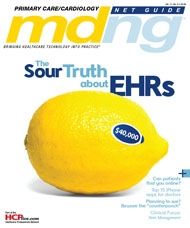Publication
Article
MDNG Primary Care
Maintenance of Certification in Cardiology
The questions asked in this article can assist candidates prepare for the Maintenance of Certification Exam in Cardiovascular Disease.
From the Pages of
Preparing for the American Board of Internal Medicine Maintenance of Certification
The following questions can assist candidates prepare for the Maintenance of Certification Exam in Cardiovascular Disease. Feedback regarding these questions is welcomed and can be sent to editor@cardiology-review.com.
These questions were prepared by Pranab Das, MD.
Questions
1. A 25-year-old black woman with a history of smoking, uncontrolled diabetes, hypertension, and morbid obesity presents to the emergency department with severe retrosternal chest pain that started 12 hours earlier. An electrocardiogram shows anterior ST-segment elevation myocardial infarction. She is emergently taken to the cardiac catheterization laboratory. Following percutaneous coronary intervention of her culprit artery, she is monitored in the critical care unit. She is continued on abciximab for 12 hours, given enoxaparin for deep vein thrombosis prophylaxis, and also starts taking aspirin and clopidogrel. A transthoracic echocardiogram is of limited value due to her morbid obesity. Two days later, as the patient is being transferred to telemetry, she develops sudden slurring of speech and left hemiparesis. A computed tomography scan of her head reveals no intracranial bleeding. She is immediately evaluated by neurology, and intravenous alteplase is administered. The patient has only minimal residual neurological deficit. What is the likely source of her neurological events?
a) A patent foramen ovale
b) Carotid artery dissection during cardiac catheterization
c) Carotid artery stenosis
d) Central nervous system vasculitis
e) Left ventricular thrombus
2. A 46-year-old white man presents to the emergency department with severe retrosternal chest pain and diaphoresis. He has multiple coronary risk factors, including smoking, hypertension, diabetes, and hyperlipidemia. The initial electrocardiogram shows 4-mm ST-segment elevation in leads II, III, and aVF, and a large R wave in lead V1. He has an elevated jugular venous pressure and a blood pressure of 84/40mm Hg. A bedside echocardiogram shows no evidence of pericardial effusion. While he is being rushed to the cardiac catheterization laboratory, he becomes extremely hypoxic. A 100% nonrebreather mask is placed, but the patient’s oxygen saturation continues to be in the low 80s. The most likely etiology of the patient’s hypoxia is:
a) Cardiac tamponade
b) Massive pulmonary embolism
c) Patent foramen ovale with right-to-left shunting
d) Spontaneous pneumothorax
e) Methemoglobinemia
3. A 72-year-old white man with a longstanding history of a heart murmur recently received a diagnosis of metastatic carcinoma of the prostate. On physical examination, his murmur is best heard at the second intercostal space on the right side during expiration while he is leaning forward, and is holodiastolic in nature. A transthoracic echocardiogram shows severe aortic regurgitation. The patient is deemed not to be a surgical candidate for correction of the aortic regurgitation. The best course of medical therapy for this patient’s chronic valvular regurgitation is:
a) Beta blocker therapy
b) Vasodilator therapy
c) Nondihydropyridine calcium channel blockers
d) Cardiac resynchronization therapy
e) Intra-aortic balloon pump
4. For patients with coronary heart disease (CHD) or CHD risk equivalents, the Adult Treatment Panel III guidelines recommend a goal low-density lipoprotein (LDL) cholesterol level of less than 100mg/dL, and an optional goal LDL of less than 70mg/dL for very high-risk patients, especially those with acute coronary syndromes. All of the following conditions are considered to be CHD risk equivalents, except:
a) Abdominal aortic aneurysm
b) Carotid artery stenosis
c) Diabetes
d) Chronic kidney disease
e) Peripheral arterial disease
5. A 65-year-old white diabetic man presents to the emergency department at 8 am with acute coronary syndrome. An elevated troponin of 4.3 is found and an electrocardiogram shows dynamic changes suggestive of ischemia. The patient is given a chewable aspirin of 325mg and intravenous unfractionated heparin. He is taken to the catheterization laboratory later that day, where he is found to have a significant right coronary artery lesion. He is treated with percutaneous coronary intervention, and a sirolimus-eluting stent is placed in the right coronary artery. The patient receives eptifibatide during and following the procedure. He is also given 600mg of clopidogrel at the end of the procedure. His recovery is uneventful, and he is discharged to home on hospital day 2 on a regimen of aspirin 325mg daily and clopidogrel 75mg daily. During his follow-up visit 6 weeks later, he reports having some dark stools over the last 2 weeks with no associated epigastric pain or hematemesis. His hemoglobin has remained unchanged. In addition to starting a proton-pump inhibitor and referring him to a gastroenterologist, the following measure will likely reduce his risk of gastrointestinal bleeding without putting him at risk of stent thrombosis:
a) Stopping the aspirin immediately
b) Stopping the clopidogrel immediately
c) Decreasing the dose of asprin to 81 mg daily and continuing the same dose of clopidogrel
d) Continuing the same dose of aspirin and changing clopidogrel to every other day
e) Stopping both the aspirin and clopidogrel as he has completed the recommended duration of dual antiplatelet therapy following drug-eluting stent placement






